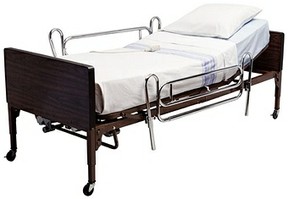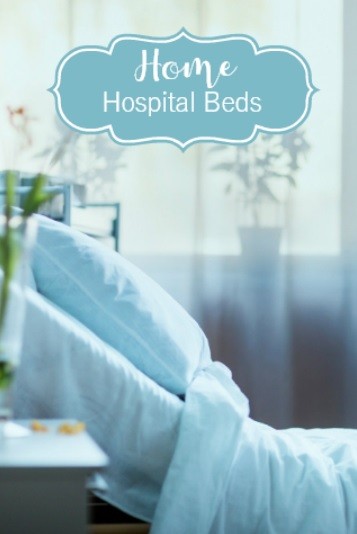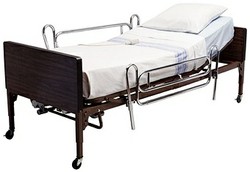 People who have mobility issues or are totally dependent on caretakers for their mobility, run the risk of getting trapped in the bedrails. Since each person differs in their sleeping habits, no one bed will work for all.
People who have mobility issues or are totally dependent on caretakers for their mobility, run the risk of getting trapped in the bedrails. Since each person differs in their sleeping habits, no one bed will work for all.
When choosing a hospital bed for use at home, it’s important to consider medical needs, comfort, and freedom of movement. Take into consideration if the person using the bed suffers with any sort of mental confusion or lack of muscle control.
New hospital bed and rail design configurations make entrapment less likely; however, it’s important to be aware of the issue when you make your purchase. Don’t hesitate to involve the doctors or nurses in your decision.
To minimize risk of entrapment, assemble the bed according to manufacturer’s instructions, make sure rails, mattresses, and bed frames are compatible, and reassess the patient’s needs on a regular basis.







 People who have mobility issues or are totally dependent on caretakers for their mobility, run the risk of getting trapped in the bedrails. Since each person differs in their sleeping habits, no one bed will work for all.
People who have mobility issues or are totally dependent on caretakers for their mobility, run the risk of getting trapped in the bedrails. Since each person differs in their sleeping habits, no one bed will work for all.






 Why Orthopedic Shoes Are the Best Choice for Your Feeton 09/17/2014
Why Orthopedic Shoes Are the Best Choice for Your Feeton 09/17/2014
 Fitness Tips for Seniorson 09/16/2014
Fitness Tips for Seniorson 09/16/2014
 Self Dressing and Adaptive Clothingon 05/05/2012
Self Dressing and Adaptive Clothingon 05/05/2012
 Checklist for Surgeryon 06/22/2012
Checklist for Surgeryon 06/22/2012



Know someone who could make use of a hospital bed at home?
@DerdriuMarriner Ideally it should plug into the wall, but make sure any extention cord can handle the electrical current.
In the UK it is possible to borrow a hospital bed from the National Health Service. My wife's mother got one on loan and when she died we simply told the authorities, who removed it.
The leftmost image of the four sample hospital-bed styles above the subheading Hospital bed entrapment looks the subtlest even as the middle image looks the securest.
The subheading Home Hospital Bed | Fire Prevention mentions that "The plug should fit snugly into the wall outlet, and not be plugged into a power strip or extension cord."
I thought that extension cords and power strips give added protection to plugs and their currents. Would they instead encourage fire or shorts?
Yes, they come in handy when recuperating at home.
For keeping a patient at home comfortable, such a hospital bed is sure a great help.